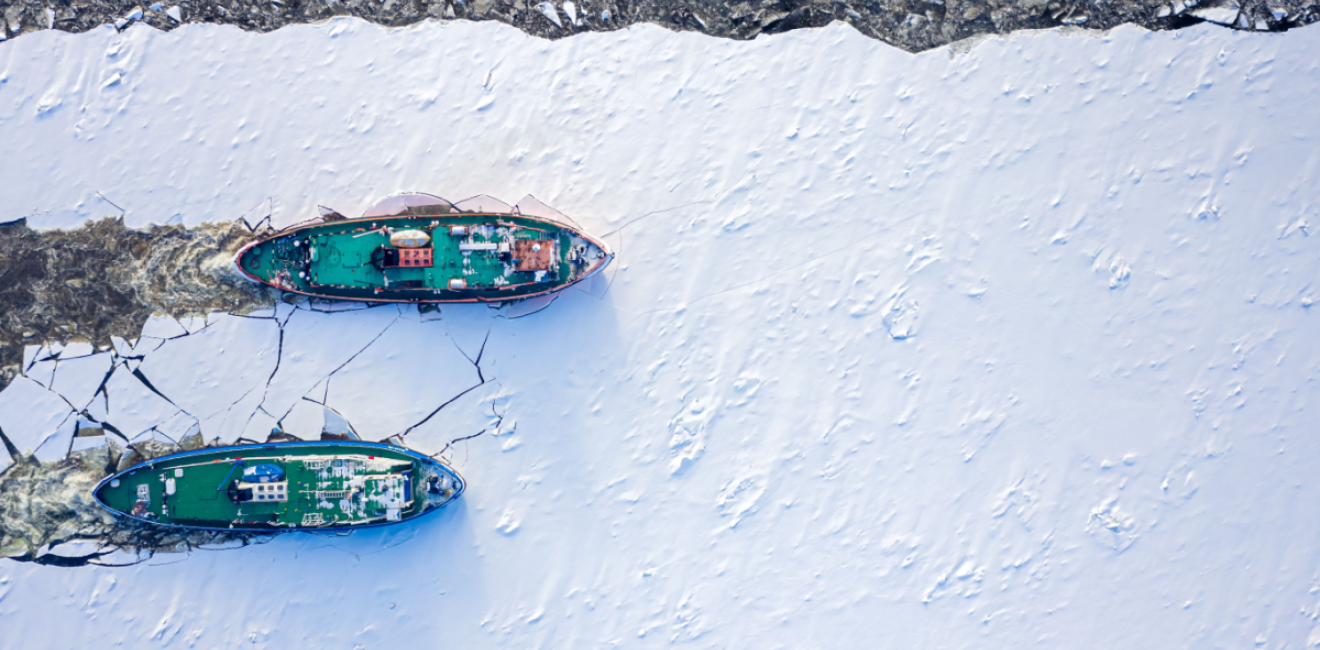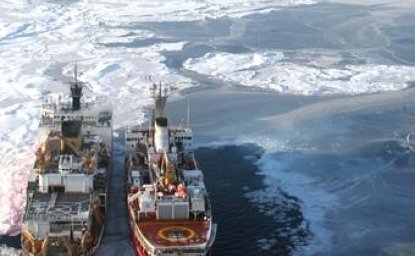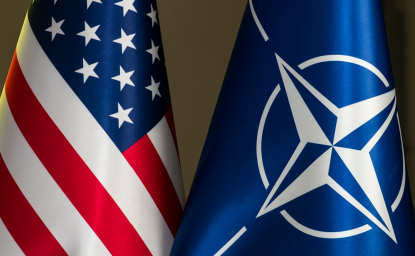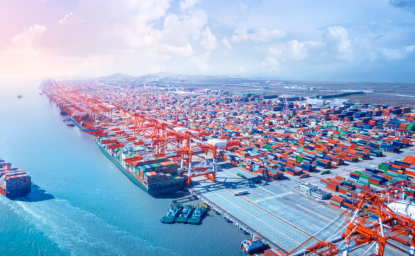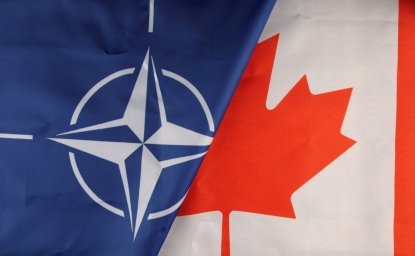ICE Pact, AUKUS and Beyond
Mark Kennedy
Director, Wahba Institute for Strategic Competition
Danger signs are flashing at the degree to which the US has allowed itself to fall behind in shipbuilding. It has fallen from global shipbuilding leadership in 1975 to 19th place today. The United Nations reports that only 0.13% of the world’s shipbuilding capacity resides in North America. In contrast, China is by far the top global shipbuilder, responsible for “more than half of the world’s commercial shipbuilding output” last year.
Unless it changes current trajectories, the US risks the hazardous possibility of trailing revisionist powers in the size of fleets it can field in key theaters. The US should do all it can to expand its domestic shipbuilding capacity. The lead time required to expand capacity and then build more ships risks extending beyond the deadlines when a greater fleet size is required. That is why it is vital to for the US to embrace collaborations such as the recent ICE Pact (with Canada and Finland) to build icebreakers, along with AUKUS (with Australia and the UK) to build more submarines. Joint effort can speed progress. Deepening these collaborations and adding others are vital to America’s maritime security.
The Arctic is a North Atlantic Treaty Organization (NATO) front receiving insufficient attention. It is rich in resources and emerging sea-lanes. It is also strategically important militarily, particularly as defense preparations in Alaska, Canada, and Nordic nations trail Russian threats. China threw its weight into the Arctic by declaring itself a Near-Arctic power. It joined Russia in sailing a naval force of 11 ships close to America’s Aleutian Islands last August. Its Polar Silk Road will be cleared with Chinese icebreakers.
The US alone has only two aging diesel icebreakers in the Arctic compared to Russia’s “seven nuclear-powered icebreakers and around 30 diesel-powered ones,” with more being built. Collectively, NATO trails Russia and China in icebreakers. Adding to the imbalance, Russia has launched a new class of combat icebreakers with high-speed guns and launchers for anti-ship and land-attack cruise missiles. These risks, coupled with the US Coast Guard’s new Polar Security Cutter program being years behind schedule and billions of dollars over budget, underlie the logic of the ICE Pact.
The Pentagon estimates that the People’s Liberation Army Navy has more than 370 ships, compared with America’s combat-ready fleet of 290 (though America has more carriers and destroyers and superior submarines). The gap is expected to widen. China’s fleet is expected to grow 21 percent by 2030, while the US Navy’s latest budget submission projects that the US fleet will remain largely unchanged. Staying ahead with submarines highlights the need for AUKUS.
These collaborations allow allies to share expertise, build supplier networks, develop programs for training a skilled workforce, and ensure interoperability. Maximizing the benefits of collaboration requires pushing past resistance points. Following China, Japan and South Korea are the largest shipbuilding nations. Some have suggested Japan, South Korea, and the US should mirror the AUKUS framework or the F-35 Lightning supplier network to create a multinational guided-missile destroyer construction program. Continued partnering with allies for ship maintenance also adds capacity and strengthens alliances.
Not only must America grow its shipbuilding capacity to stay ahead, but it will also need to foster a network of allied capacity to ensure it can meet urgent needs and rapidly resupply to cover losses in the event of conflict. For all this, the US must embrace the ICE Pact, AUKUS, and more.
Icebreakers Are Part of the Shipbuilding Crisis
Rebecca Pincus
Director, Polar Institute
The recently announced Icebreaker Collaboration Effort (ICE-PACT) by the US, Canada, and Finland, is a collaboration intended to strengthen shipbuilding and maritime industrial capacity through closer cooperation on polar icebreakers.
Icebreakers are highly specialized platforms, built to withstand some of the most punishing conditions on earth. They sail directly into ice that can crush ships and pierce hulls, and into storms that can ice over superstructures until ships become so top-heavy they capsize. The engineering requirements for polar icebreakers are daunting.
In the US, the specialized expertise required to build polar icebreakers has largely vanished in the decades since the last such ship was built. The US Coast Guard’s current acquisition program, the Polar Security Cutter, has experienced significant challenges, including time delays and cost overruns.
The Coast Guard’s challenges echo similar problems bedeviling US Navy shipbuilding. Navy Secretary Del Toro has championed efforts to spur competition from foreign shipbuilders, including calling for coproduction with foreign shipyards and increasing reliance on overseas repair and maintenance. These efforts are constrained by limits on Coast Guard and Navy ability to contract with foreign shipyards.
In contrast to Del Toro’s emphasis on increasing competition, US shipbuilding interests usually call for more predictability in orders, more subsidies to industry, and more investment in labor programs.
ICE-PACT sidesteps these questions in favor of three objectives: information sharing, collaboration on workforce development, and an invitation to allies and partners to purchase icebreakers built in American, Canadian, and Finnish shipyards. Here the ICE-PACT announcement echoes another trilateral effort—AUKUS—which similarly emphasized information sharing and strengthening of all parties’ industrial bases.
The ICE-PACT agreement is a first step: the US, Canada, and Finland will engage in trilateral negotiations this year on a framework for implementation. In the meantime, icebreaker construction programs are ongoing in both the US and Canada. These are likely to be little impacted by the new agreement.
The primary impact of ICE-PACT at this point is the demonstration of high-level attention to the issue by the White House, and the credence this lends efforts to find creative solutions to the broader set of US shipbuilding woes. While unlikely to reach the scale and scope of AUKUS, the ICE-PACT agreement signifies sustained interest from the Biden administration in partnering with key allies on critical naval technology.
New NATO Ally Finland Flexes Its Icebreaker Expertise
Jason C. Moyer
Program Associate, Global Europe Program
The new trilateral Icebreaker Collaboration Effort Pact (ICE Pact) announced last week between Canada, Finland, and the United States provides a leap forward in closing the icebreaker gap between Russia and the West. Finland is a net contributor to the NATO alliance, as was stressed at the recent NATO Summit in Washington. Lending the country’s icebreaking know-how is a tangible benefit for the countries participating in the new partnership, as well as for NATO as a whole.
As a new NATO Ally, Finland brings important icebreaker and Arctic expertise to the Alliance. Finnish President Alexander Stubb remarked that NATO membership was essential to begin this trilateral cooperation. Finland is an icebreaker superpower, primarily because its ports freeze over every winter. Icebreakers keep Finnish ports open year-round and ensure that imports and exports flow. Finland is also the world's leading icebreaker designer, having designed 80% of the world’s icebreakers and built 60% of them. It has championed breakthroughs in using liquefied natural gas (LNG) in its newest icebreakers. The Polaris, which debuted in 2017, is the most environmentally friendly icebreaker in operation and is powered by both LNG and diesel. Climate change has added unpredictability and new challenges to the operating conditions of icebreakers in recent years.
More details will be known later this fall. What is known of the ICE Pact is it is modeled after the AUKUS nuclear submarine trilateral arrangement between Australia, the UK, and the US. The US and Allies are seeking to build between 70 and 90 new icebreakers in the next decade. Finnish shipyards can deliver a polar-class vessel within 24 months once ordered for at least a quarter of the cost of what it would take to build them in the US. This partnership will likely benefit all three partner countries, with Finland receiving a considerable economic influx as a result of sharing its icebreaker expertise. This should bring new jobs and more work, both to its shipyards and US shipyards as it shares it technology. The ICE Pact also provides an opportunity for Canada, which was criticized at the Washington Summit for not investing more in its Arctic capabilities or being close to the minimum 2% spending of GDP on defense nor planning on reaching 2% until 2032 (while some NATO Allies are at 3%). Canadian Defense Minister Bill Blair noted that by 2050, the Arctic Ocean could be the most efficient shipping route between Europe and East Asia, so it is important for Canada, the US, and Europe to have icebreaking capabilities to ensure safe passage through the region.
The ICE Pact is a win-win for the three members of the new trilateral agreement. Finland shares its finely honed proficiency in icebreaker building and further cements its value to the NATO Alliance. Canada also shares its icebreaker knowledge–with the second-largest icebreaker fleet (behind Russia)–and can invest more in its Arctic capabilities. Meanwhile, the US can play catch-up and update its massively outdated icebreaker fleet, thereby closing the icebreaker gap between the West and Russia. More icebreakers in the region will ensure that North America and Europe can operate effectively in the Arctic in the future.
ICE Pact Turns the Ship Around on West’s Atrophying Icebreaker Building Capacity
Heather Exner-Pirot
Global Fellow for Polar Institute, Canada Institute, and Wahba Institute for Strategic Competition; Director of Energy, Natural Resources and Environment, Macdonald-Laurier Institute
The ICE Pact signed between Canada, Finland and the US on the sidelines of last week’s NATO Summit marks an important step in bolstering the West’s icebreaker shipbuilding capacity.
While Russia has steadily expanded its world-leading fleet, and China is making significant inroads, Canada and the US have let their icebreakers age and their shipbuilding capacity atrophy. Even with the recent resolve to reverse trend and commit billions in new dollars to icebreakers, previous neglect has led to shipbuilding programs that are frequently over time and over budget. The US, notably, lacks yard capacity, specialized workforce, and experience in icebreaker shipbuilding, and has faced continuous delays in its Polar Security Cutter program. The ICE Pact aims to turn the ship around.
The Russians are dominant in icebreaking capacity, with a fleet of over 30 diesel powered icebreakers and the world’s only nuclear icebreakers. Adding to its Arktika and Tamyr class nuclear icebreakers, Russia has already launched three powerful new icebreakers as part of its Project 22220, with two more expected in 2024 and 2026. It committed to the 6th and 7th vessels in the fleet’s series in 2023, for delivery by the end of the decade.
Russia is an Arctic icebreaking pacesetter because its economy depends far more on its northern maritime route than anyone else. As western sanctions limit its market for Arctic LNG and oil to more accessible Europe, it increasingly has to move its products east, through the seasonally ice-covered Northern Sea Route, to reach Asian customers. This is driving icebreaking demand.
By contrast, Alaskan and Norwegian maritime trade is plied through ice free waters, and resource development and maritime trade through Canada’s Northwest Passage is still minimal. Many of the icebreakers Canada’s coast guard operates are dedicated to keeping the Great Lakes and St. Lawrence Seaway open in winter. Likewise, most of Finland’s and Sweden’s icebreakers are used for the Baltic Sea’s winter.
But Russian icebreaking is not just limited to economic development anymore. Its first armed combat icebreaker, the Ivan Papanin, is in sea trials and scheduled to join Russia’s Northern Fleet by the end of 2024. And China is quickly gaining capacity, having commissioned its fourth polar-capable vessel, the Jidi, last week.
The ICE Pact is a response to the West’s relative, and untenable, weakness. Canada has been enhancing its icebreaking program for several years now, and Finland has long been a leader in both ice vessel technologies, through Aker Arctic; and shipbuilding, through Helsinki Shipyards. Western sanctions dried up the latter’s Russian contracts, leaving it looking for new investors. Quebec-based shipbuilder Davies snapped it up in 2023. Helsinki Shipyards’ know-how is now supporting Davies’ ambitious icebreaking program, led by government contracts for ten new ice breaking vessels: a flagship polar icebreaker, six heavy program icebreakers, and three medium icebreakers.
But that’s not all. On the west coast in Vancouver, Seaspan has already delivered three new icebreaker vessels for the Canadian Coast Guard, with a fourth to be delivered early next year. It is also designing and building Canada’s other heavy polar icebreaker and is well into the design of up to 16 additional medium icebreaker vessels that would be built and delivered over the next two decades. Finally, in Halifax, Irving has delivered four of its Arctic Offshore Patrol Vessels to the Royal Canadian Navy, with two more nearing completion for the Navy and two more being constructed for the Coast Guard.
Icebreakers are a niche and highly complex ship design. The NATO alliance will save time and money, as well as enhance its preparedness and capabilities, by leveraging its best asset: the ability to work together. The ICE Pact is a smart move and will help counter Russia’s dominance in the icebreaking field.
New Trilateral “ICE Pact” an Overdue Step by the West
Klaus Larres
Fellow, Global Europe Program and Kissinger Institute on China and the United States; Richard M Krasno Distinguished Professor in History & International Affairs, University of North Carolina at Chapel Hill
Many responsible policymakers and most knowledgeable scholars denounce the creation of a world divided into spheres of influence. Yet, such a divided world is increasingly coming into being – including in the Arctic - with China and Russia, and a number of allies, on one side and the US and its transatlantic and Asian allies on the other side. Seen from the US and its like-minded partners this is very much a development that is regrettable but appears to be necessary to react and respond to Moscow’s and Beijing’s global activities. In particular, Putin’s war in Ukraine and China’s assertive behavior in the South China Sea have brought the NATO allies as closely together as seldom before. It has led to an expansion of western influence in crucial global theatres. Sweden and Finland joined NATO after many years of neutrality. In 2021 the trilateral security partnership AUKUS was created between Australia, the UK and the US to resist China’s encroaches in the wider Indo-Pacific area.
The latest incarnation of a trilateral club, this time between the US, Canada, and Finland, is the so-called “ICE Pact,” created on the sidelines of NATO’s 75th anniversary summit in Washington, DC, in July 2024. The “Icebreaker Collaboration Effort” (ICE), as the Pact is officially called, is meant to increase western influence into the Antarctic in order to compete more vigorously with the expanding interests of Russia and China in the area. Thus, the ICE is very much a reaction to Russian and Chinese activities in the Polar region, which due to climate change and the melting of the ice is becoming increasingly accessible to new shipping routes and the extraction of the natural resources far beneath the Arctic ice.
China and Russia began cooperating on the Arctic in 2017, when Xi Jinping unveiled the idea of a “Polar Silk Road” during his visit to Moscow, which he saw as part of China’s global “Belt and Road Initiative.” In a subsequent Arctic policy White Paper Beijing claimed that although China was not bordering the Arctic region China was in fact a “near-Arctic state” with an interest in the scientific exploration of the region and the exploitation and development of the Arctic’s rich oil, gas, mineral and fishing resources. Only recently China has launched its fourth next-generation polar icebreaker (the Jidi), which will be based at China’s seven major stations at both poles, and are meant to strengthen Beijing’s expanding polar fleet. With over 40 ships Russia possesses the world’s largest and by far most capable Arctic fleet. At present the US has a mere two heavy icebreakers, which are rather aged and out of date.
The trilateral US-Canada-Finland ”Ice Pact” has thus two major objectives, a geopolitical one and a highly pragmatic dimension. First of all, in competition with Beijing and Moscow it is the projection of western power and influence into the strategically and economically increasingly important Antarctic region.
Secondly, the US and its allies bordering the Antarctic, are increasingly concerned that they are losing the technical expertise and capability of being present in the region. The “Ice Pact” is thus also all about rebuilding the icebreaker shipbuilding expertise in these three countries. The decline of the specialized shipbuilding expertise since the 1970s – an expertise crucial for the manufacturing of heavy icebreakers and semi-submersible heavy-lift ships - thus has important national security implications. A report by the Polar Research Institute of China, a governmental agency, recently claimed, for instance, that China was ready to deploy a large network of underwater listening devices for the Arctic Ocean.
By contrast the US’s Polar Security Cutter program has been plagued by significant delays and huge cost overruns (from an estimated $3.2 billion in 2021 to a possible $10 billion by 2029, when eventually the first of five new icebreakers might be launched). The ICE launched at the NATO summit foresees the development of interoperability of icebreakers between the US, Canada and Finland and specialized workforce development in all three countries, which is also meant to encourage other allied nations to invest in and purchase icebreakers from those countries.
Thus, the new trilateral “Ice Pact” announced at the Washington NATO summit is the western attempt to collaborate in order not to leave the Arctic Ocean with its huge natural resources, important shipping routes and crucial strategic location exposed to the influence of and exploitation by China and Russia. While this was long overdue, an attempt to also collaborate with Beijing and Moscow, if possible, still ought to be made. Strategic competition may be required but constructive and forward-looking (rather than naïve) global strategic collaboration would be much better.
Indo-Pacific Stakes at Play in NATO Summit and Arctic Power Competition
Prashanth Parameswaran
Global Fellow, Wahba Institute for Strategic Competiton; CEO and Founder, ASEAN Wonk Global; Senior Columnist, the Diplomat
The new Icebreaker Collaboration Effort (ICE Pact) between Canada, Finland and the U S spotlights the stakes at play for Indo-Pacific countries amid the increasing focus on flexible minilaterals; increasingly global and cross-regional conversation in areas like the Arctic; as well as intensified great power competition.
First, the ICE Pact highlighted the increasing role of flexible minilaterals in how countries are working together across strategic spaces and sectors. Indo-Pacific countries have been at the heart of this in recent years within US policy, whether it be through global, sector-based institutions like the Minerals Security Partnership or region-specific ones like the Quad and the more recent “Squad” (US, Australia, Japan, Philippines). While the ICE Pact is initially between three countries, US officials have privately said they see this as part of a broader conversation involving a wider range of like-minded states about how to meet global needs for strategic capabilities including icebreakers as well as shipbuilding capacity and workforce expertise.
Second, the ICE Pact is the latest datapoint in the increasingly global and cross-regional nature of geopolitical conversations, including in the Arctic Region. The context within which it was announced was on the sidelines of the NATO summit, where four of NATO’s Indo-Pacific partners (IPP or IP4) – Australia, Japan, New Zealand and South Korea – attended for the third consecutive time. While the ICE Pact itself has an Arctic focus and initially groups three countries in North America and Europe, it is worth noting that Artic conversations too are gradually becoming more global. To take just one example, the Arctic Council organized its first-ever Japan Forum last year on Asia’s role in the future of the Arctic in a closely-watched region-specific development. Asia’s presence at the Council has long been evident, with five of the thirteen observer states being from Asia – China, India, Japan, Singapore and South Korea.
Third, the ICE Pact also spotlighted intensifying great power competition, which has implications for Indo-Pacific countries as well. The ICE Pact comes amid increasing concerns by US policymakers about Sino-Russian cooperation in the Arctic and the glaring gap in polar icebreaking fleet capabilities. Asian countries may not be Arctic countries, but they are aware that a more contested Arctic could exacerbate concerns about major power competition and the behavior of China and Russia evident in the South China Sea and with the Ukraine invasion. Developments like melting Arctic ice sheets could also shift the patterns of international trade amid concerns around climate change and opportunities in shipping or science. Those stakes explain why we have seen expressions of Arctic interest among some key Indo-Pacific countries, including non-US treaty allies. For instance, in South Asia, India released a designated Arctic policy. In Southeast Asia, Singapore has been playing up its expertise across domains such as disaster preparedness, maritime infrastructure and environmental research.
To be sure, the exact parameters of the ICE Pact remain to be seen. US officials have indicated cooperation is likely to concretize after the signing of an MOU, and that more countries could be added thereafter. But as with any new minilateral mechanism, there will naturally be questions about its deliverability and sustainability across capitals until it begins showcasing results. Additionally, collaboration in areas like workforce development and shipbuilding will also feed into complexities surrounding the core competencies of like-minded states and debates on the contours of industrial policy and resourcing. While these dynamics will take months and years to develop, the significance of the ICE Pact announcement is already clear within the broader strategic conversations occurring globally, regionally and sectorally.



